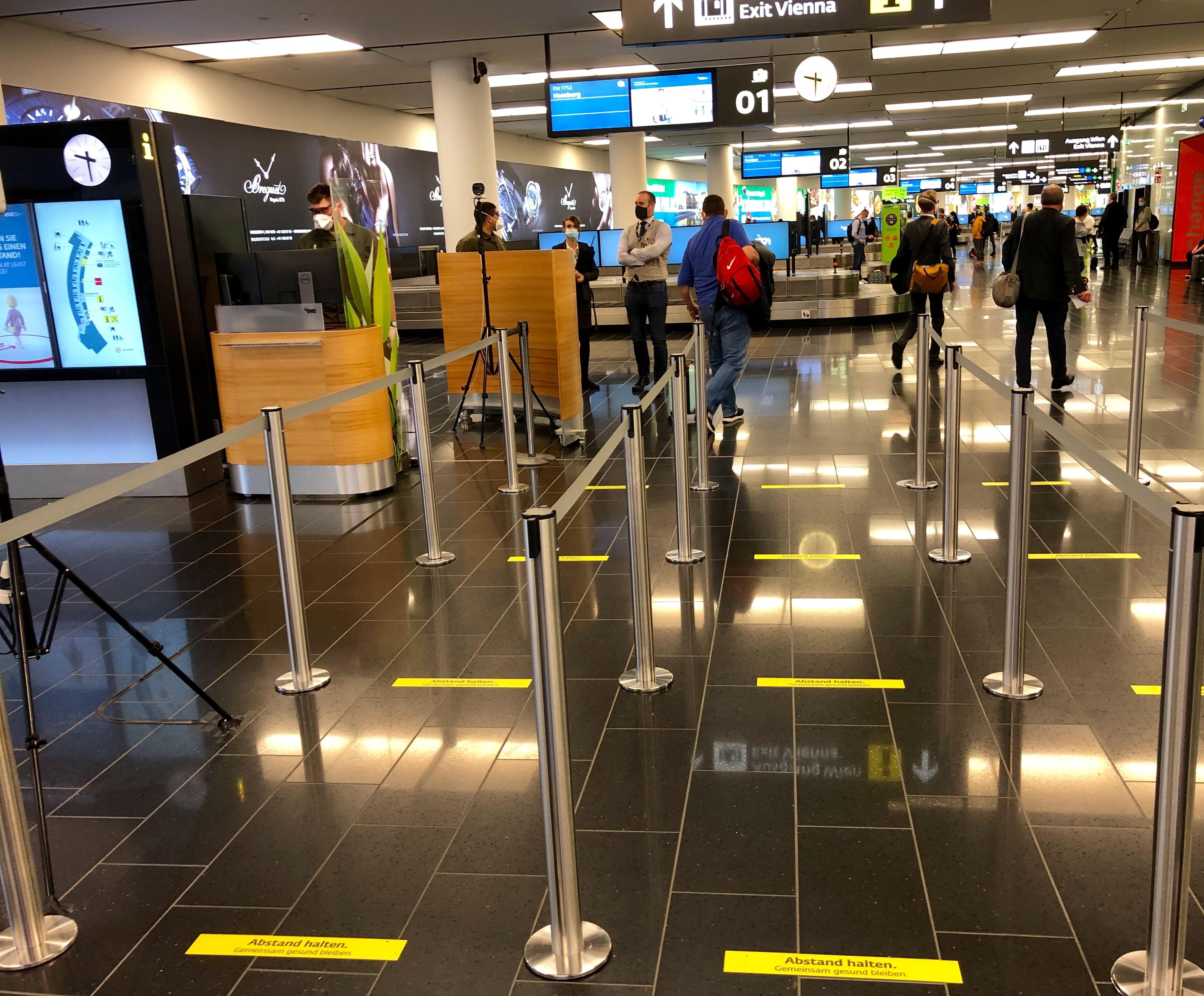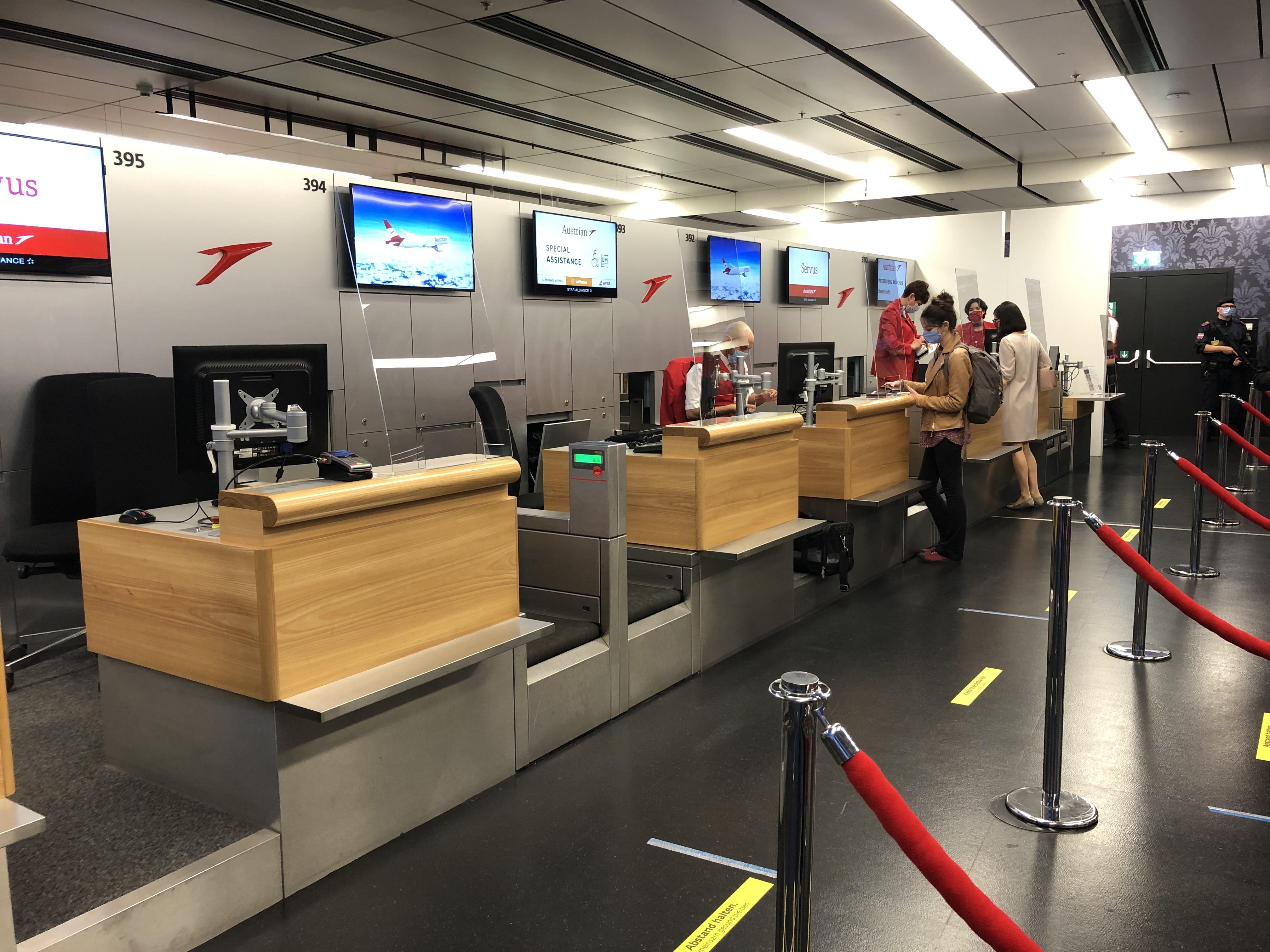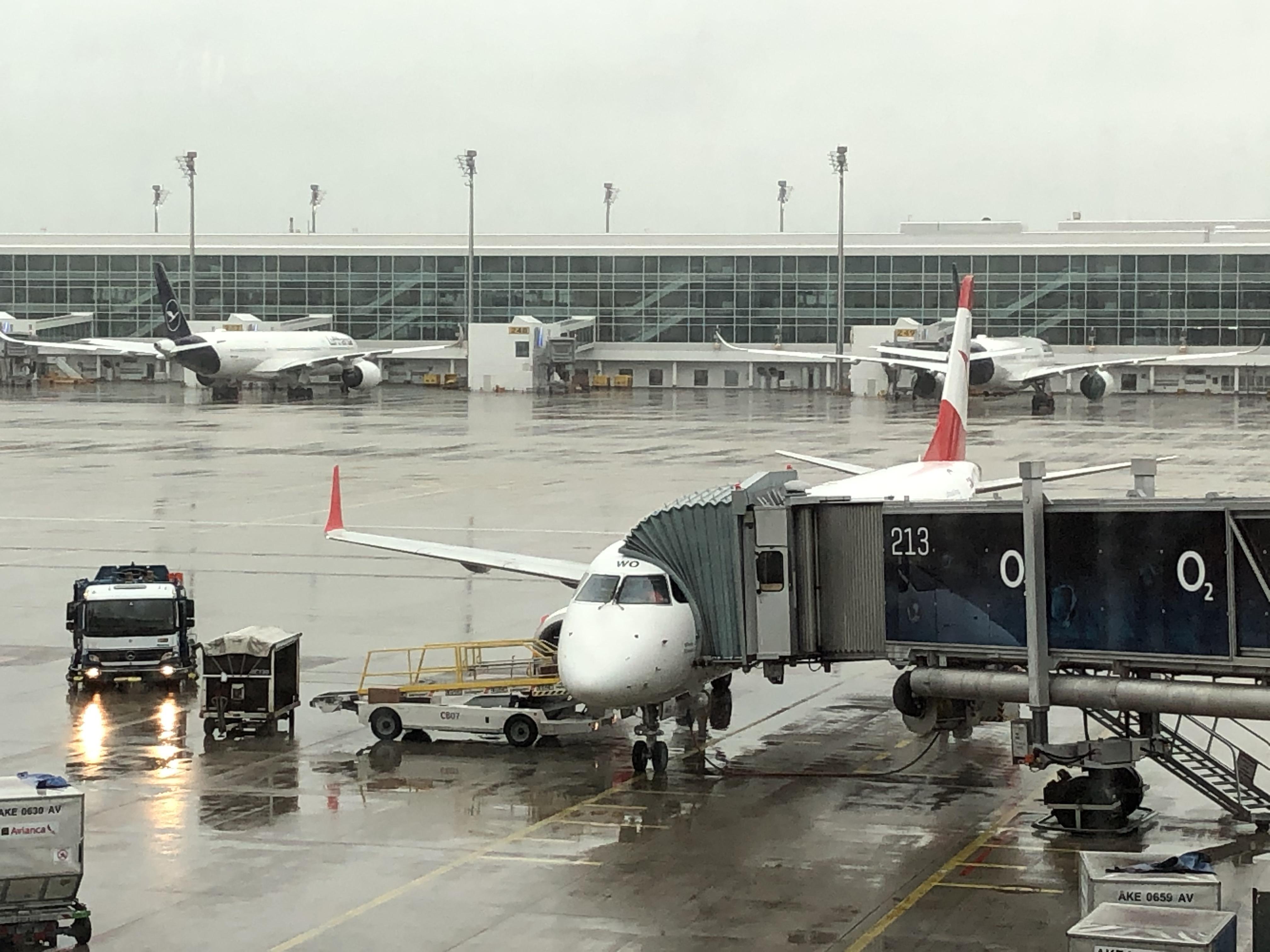
Arriving temperature check
Credit: Kurt Hofmann
Passengers arriving at Vienna Airport must undergo an automatic temperature check.

New Guidelines
Credit: Kurt Hofmann
Airport signs remind passengers of new guidelines on wearing masks and physical distancing. On the left side of the picture, more flights continue to show up on departure screens.

Masked customer service representatives
Credit: Kurt Hofmann
Masked customer service representatives greet early-morning masked passengers at Vienna Airport for check-in.

Physical distancing
Credit: Kurt Hofmann
Austrian check-in area shows yellow floor decals indicating physical distancing rules. Vienna Airport expects only 10,000-20,000 departing passengers per day in July and August 2020, compared to 100,000 passengers per day during the year-ago summer months.

CEOs welcome passengers
Credit: Kurt Hofmann
Vienna Airport CEO Julian Jaeger (left) and Austrian Airlines CEO Alexis von Hoensbroech join Austrian Airlines’ staff to welcome passengers on the first flight, in the early morning hours of June 15.

Austrian Airlines employees welcome first passengers
Credit: Kurt Hofmann
Many Austrian Airlines employees welcome first passengers. CEO Alexis von Hoensbroech said there are no layoffs planned within the next two years as short-time working—implemented after the COVID-19 outbreak—will continue. The carrier’s 7,000 employees will make an accumulated crisis contribution of about €300 million ($339 million) in salary forfeitures.

Social distancing on airbridge
Credit: Kurt Hofmann
Signs on the airbridge floor remind passengers to physical distance. Future new boarding procedures are still being tested.

Operating smaller aircraft
Credit: Kurt Hofmann
From June 15, Austrian Airlines is mainly operating smaller aircraft, such as the Embraer E195, Dash 8 Q400s and several Airbus A320s. However, the carrier will only use around 30% of its fleet during the summer, which could increase to 50% by year-end. The remaining fleet will be flown from Vienna to other airports for long-term storage.

Pilots and crew prepared to fly
Credit: Kurt Hofmann
Captain Rudolf Buchsteiner at the controls. During the grounding, Austrian Airlines’ cockpit crews continued to use flight simulators to keep the professional level of its cockpit crews as high as possible.

Austrian Airlines CEO Alexis von Hoensbroech
Credit: Kurt Hofmann
Austrian Airlines CEO Alexis von Hoensbroech during the 40-min. flight to Munich. He said the carrier is only operating 5% of its capacity at the restart. “That means we actually don’t operate. We hope to operate 20% in July, then 30% and by the end of the year 50% of capacity. By 2022-23, we hope to be back to 80% capacity like before the crisis.”

Onboard services
Credit: Kurt Hofmann
Onboard services have been reduced. In business class, only cold snacks will be served.

Masks are mandatory
Credit: Kurt Hofmann
Wearing a mask during flights is mandatory for both passengers and crew. The carrier has 3,000 flight attendants.

Load factor around 70% on first day
Credit: Kurt Hofmann
Austrian Airlines achieved an overall load factor of around 70% on its first day of restarting operations.

Munich Airport
Credit: Kurt Hofmann
Munich Airport, Lufthansa Group’s second largest hub, has also handled more flights since June 15. Here, a lone Airbus A319 is parked at the main terminal. Munich’s Lufthansa satellite terminal remains completely closed.

More social distancing reminders
Credit: Kurt Hofmann
Lufthansa boarding gate. Physical distancing reminders are everywhere throughout the airport.

Munich Airport terminal
Credit: Kurt Hofmann
The Munich Airport terminal, which in pre-COVID-19 times was bustling with passengers at shopping and restaurant facilities, now sees many fewer customers.

Lounges closed
Credit: Kurt Hofmann
All Lufthansa lounges at Munich Airport are closed, except one in the Schengen Area of Terminal 2.

Austrian Airlines Embraer E195 awaits boarding
Credit: Kurt Hofmann
Austrian Airlines Embraer E195 awaits boarding for the next flight to Vienna. In the background, Lufthansa Group’s satellite terminal—which remains closed—is surrounded by new Airbus A350-900s, most of which are not flying.

Entry and Transit Declaration form
Credit: Kurt Hofmann
Air traffic between Austria and Germany is traditionally strong; however, every passenger must fill out an Entry and Transit Declaration form to disembark the aircraft.

Arriving temperature check
Credit: Kurt Hofmann
Passengers arriving at Vienna Airport must undergo an automatic temperature check.

New Guidelines
Credit: Kurt Hofmann
Airport signs remind passengers of new guidelines on wearing masks and physical distancing. On the left side of the picture, more flights continue to show up on departure screens.

Masked customer service representatives
Credit: Kurt Hofmann
Masked customer service representatives greet early-morning masked passengers at Vienna Airport for check-in.

Physical distancing
Credit: Kurt Hofmann
Austrian check-in area shows yellow floor decals indicating physical distancing rules. Vienna Airport expects only 10,000-20,000 departing passengers per day in July and August 2020, compared to 100,000 passengers per day during the year-ago summer months.

CEOs welcome passengers
Credit: Kurt Hofmann
Vienna Airport CEO Julian Jaeger (left) and Austrian Airlines CEO Alexis von Hoensbroech join Austrian Airlines’ staff to welcome passengers on the first flight, in the early morning hours of June 15.

Austrian Airlines employees welcome first passengers
Credit: Kurt Hofmann
Many Austrian Airlines employees welcome first passengers. CEO Alexis von Hoensbroech said there are no layoffs planned within the next two years as short-time working—implemented after the COVID-19 outbreak—will continue. The carrier’s 7,000 employees will make an accumulated crisis contribution of about €300 million ($339 million) in salary forfeitures.

Social distancing on airbridge
Credit: Kurt Hofmann
Signs on the airbridge floor remind passengers to physical distance. Future new boarding procedures are still being tested.

Operating smaller aircraft
Credit: Kurt Hofmann
From June 15, Austrian Airlines is mainly operating smaller aircraft, such as the Embraer E195, Dash 8 Q400s and several Airbus A320s. However, the carrier will only use around 30% of its fleet during the summer, which could increase to 50% by year-end. The remaining fleet will be flown from Vienna to other airports for long-term storage.

Pilots and crew prepared to fly
Credit: Kurt Hofmann
Captain Rudolf Buchsteiner at the controls. During the grounding, Austrian Airlines’ cockpit crews continued to use flight simulators to keep the professional level of its cockpit crews as high as possible.

Austrian Airlines CEO Alexis von Hoensbroech
Credit: Kurt Hofmann
Austrian Airlines CEO Alexis von Hoensbroech during the 40-min. flight to Munich. He said the carrier is only operating 5% of its capacity at the restart. “That means we actually don’t operate. We hope to operate 20% in July, then 30% and by the end of the year 50% of capacity. By 2022-23, we hope to be back to 80% capacity like before the crisis.”

Onboard services
Credit: Kurt Hofmann
Onboard services have been reduced. In business class, only cold snacks will be served.

Masks are mandatory
Credit: Kurt Hofmann
Wearing a mask during flights is mandatory for both passengers and crew. The carrier has 3,000 flight attendants.

Load factor around 70% on first day
Credit: Kurt Hofmann
Austrian Airlines achieved an overall load factor of around 70% on its first day of restarting operations.

Munich Airport
Credit: Kurt Hofmann
Munich Airport, Lufthansa Group’s second largest hub, has also handled more flights since June 15. Here, a lone Airbus A319 is parked at the main terminal. Munich’s Lufthansa satellite terminal remains completely closed.

More social distancing reminders
Credit: Kurt Hofmann
Lufthansa boarding gate. Physical distancing reminders are everywhere throughout the airport.

Munich Airport terminal
Credit: Kurt Hofmann
The Munich Airport terminal, which in pre-COVID-19 times was bustling with passengers at shopping and restaurant facilities, now sees many fewer customers.

Lounges closed
Credit: Kurt Hofmann
All Lufthansa lounges at Munich Airport are closed, except one in the Schengen Area of Terminal 2.

Austrian Airlines Embraer E195 awaits boarding
Credit: Kurt Hofmann
Austrian Airlines Embraer E195 awaits boarding for the next flight to Vienna. In the background, Lufthansa Group’s satellite terminal—which remains closed—is surrounded by new Airbus A350-900s, most of which are not flying.

Entry and Transit Declaration form
Credit: Kurt Hofmann
Air traffic between Austria and Germany is traditionally strong; however, every passenger must fill out an Entry and Transit Declaration form to disembark the aircraft.

Arriving temperature check
Credit: Kurt Hofmann
Passengers arriving at Vienna Airport must undergo an automatic temperature check.
Click to enlarge.
Austrian Airlines, which temporarily suspended regular operations March 18 because of the COVID-19 pandemic, restarted flights from Vienna International Airport June 15. The Lufthansa subsidiary will slowly increase operations from Vienna over the next several weeks.
Correspondent Kurt Hofmann was onboard Austrian’s first flight to Munich aboard an Embraer E195, and brings exclusive photos of what post-COVID-19-travel looks like from airport to onboard the aircraft.
Get regular analysis and insights from Aviation Week Network’s award-winning editorial and data teams on technology and business advances impacting the global aviation, aerospace and defense industries
Not a subscriber? Sign up here.




















Comments
GREAT messages, with 19 photos (in the large size with text); but REALLY bad small photos that I can copy... but will not because they
are sooo poor. PLEASE email the good 'stuff' at <jgodston@gmail.com> Thanks! Joel Godston, a pilot for 50+ years
GREAT messages, with 19 photos (in the large size with text); but REALLY bad small photos that I can copy... but will not because they
are sooo poor. PLEASE email the good 'stuff' at <jgodston@gmail.com> Thanks! Joel Godston, a pilot for 50+ years